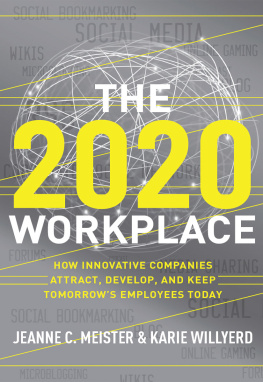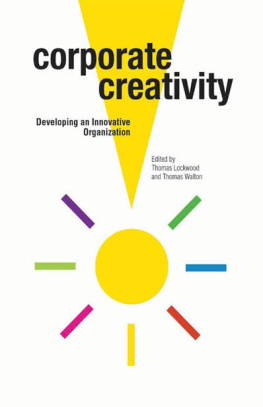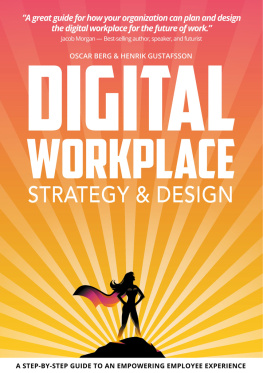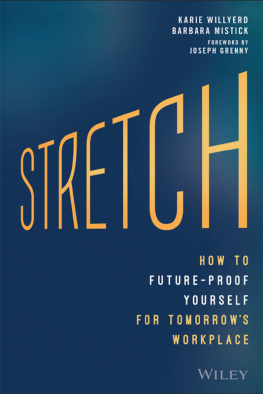For Bob, Danielle, and my parents: everything is possible with you by my side.
To my tribe: the friends, family, and neighbors who provided emotional support but sacrificed playtime with me for the last two years and occasionally insisted on restorative time at a beach house, a fly-fishing expedition, a boat ride around the lagoon, playing with grandchildren, or a trip to wine country. You make life so much more interesting.
The 2020 Workplace
Who could have guessed that one of the big differences between life now and ten years ago would be our growing dependence on a mathematician who died nearly 250 years ago? If youve ever used Google, then you have relied on the work of Thomas Bayes, whose theorem is the basis of everything from running Googles search engine to predicting which door to choose on Lets Make a Deal . Although the complex theorem largely belongs in the provenance of mathematicians, engineers, and scientists, for the rest of us, it can be simply stated: the likelihood that something will happen can be plausibly estimated by how often it occurred in the past.1 From this simple premise comes the revolution we have all experienced in the last ten years.
Think back to ten years ago: in the year 2000, a presidential election was determined by malfunctioning paper voting cards; millions if not billions of dollars had just been invested in averting the software code ambiguity threat known as Y2K; joint ventures with China were just getting started for most global companies; and the dot-com boom was on its way to becoming the dot-com bust. Google had just moved out of its garage office in Menlo Park, California; Apple was considered to be on the skids; YouTube was still five years away from being invented; and Facebooks creator was still in high school. What a difference a decade makes, not only in the tools we use to remain productive but in how we live our day-to-day lives. Who could have imagined the profound changes of the last ten years? Is there any reason to believe the changes during the next ten years will not be just as profound?
Ludwig Mies van der Rohe, a leader of modern architecture, once said, Architecture is the will of an epoch translated into space. One of his crowning achievements was the Toronto Dominion Tower, where the executive floor and boardroom remain gloriously pristine and painstakingly maintained to his original, Austin Powers like vision of the late 1960s. The boardroom table seats eighty-eight people. Made from one solid piece of wood, it is so large it had to be lifted in while the skyscraper was under construction, and it has never been moved since. When needed, replacement carpet is loomed on the same mills, according to the original specifications. Yet even an absolute commitment to historical authenticity faces the need for progress. In 1967, no one envisioned the need for people to sit around a table to collaborate together on the executive floor. After all, the hierarchy was clearly defined as the chairman, the board of directors, and the CEO; there was no need for collaborative space. Times have changed, though, and one of the few concessions to the original architectural vision for the floor has been to bring a round table into the former chairmans office, to allow dining and collaboration in a more egalitarian environment.
Likewise, organizations translate the will of the epoch not only into the physical spaces they create but also into the decisions about the talent they select and the structure they create within the firm. These decisions are crucial because although employees no longer stay at one company for life, the decisions that are made about who is hired, developed, and promoted endure for years. As such, we argue that a forward-thinking mind-set is a mandate for business executives, and too little is done to ground the discussion of the future in the needs and requirements of today. Our goal with this book is to stimulate that conversation.
WHY YOU NEED THIS BOOK NOW
For years, the much-feared and overly publicized war for talent has been predicated on the assumption that the Baby Boomers (those people born between 1946 and 1964) would follow the same retirement schedule as the prior generation, the Traditionalists (those born prior to 1946), and begin retiring in large numbers in 2007.2 However, with a decades worth of wealth obliterated in the financial crisis of 20082009, that assumption is no longer valid. Men and women who are healthy at 60, according to the World Health Organization, will on average be physically capable of working until they are 74 and 77, respectively.3 If Baby Boomers now work as long as possible, that means that the leading edge of the Boomers may not begin retiring until 2020, when the quest for top talent will assuredly be in full swing.
All the major factors that will define this 2020 workplace are already in play. The future new employees, whom we call Generation 2020, are now in their middle school years. The technologies that will define the 2020 workplace are in design stages today. Emerging large-scale economies are rapidly entering as major forces. The workplace of tomorrow is being shaped today, driven primarily by globalization, the introduction of new ways of working, the usage of emerging technologies, and the shifting demographics of the workforce.
The best companies are already preparing their strategies to win the quest for top talent. The 2020 workplace will be defined by this acute vision20/20 visionwith regard to recruiting strategies, customizable employee development and benefits, agile leadership, and the power of social networks.
The 2020 workplace : An organizational environment that provides an intensely personalized, social experience to attract, develop, and engage employees across all generations and geographies.
In this book, the 2020 workplace means one that provides an intensely personalized, social experience to attract, develop, and engage employees across all generations and geographies. The organizations that create a competitive advantage in the 2020 workplace will do so by instituting innovative human resource practicesby first defining an authentic core set of organizational values and then augmenting these by leveraging the latest tools of the social Web to reimagine learning and development, talent management, and leadership practices.
This book pays special attention to the use of social media to attract, motivate, connect with, engage, develop, retain, and listen to employees. The marketing profession has realized the potential of social media to connect with prospective and current customers, as popularized in books such as Groundswell .4 We believe that as more and more of the workforce is made up of digital natives, the need for business executives to speak the language of their employees in the form of social media will become a requirement.5 Yet at its core, the social media revolution is not about technologyits a social movement that is all about creating a community. This makes it even more imperative for business executives to be in the game.
The landscape is exciting and dynamic, and it promises to redefine much of the conventional wisdom about work, organizational success, personal accomplishment, and so much more. As we scan the workplace of the future, we see that everything we know about workwhere we work, how we work, what skills we need to stay employable, what technologies we use to connect with colleaguesis changing. And these changes will only continue to accelerate as we move toward 2020 because the Millennial Generation, which refers to the 88 million people born between the years 1977 to 1997, will make up nearly half of the workforce by 2014. Employers must prepare now for this multigenerational workforce, and if organizations are to be ready, it will take the foresight and actions of those who are most responsible for preparing the leadership and employee implications of the organizational strategy.











